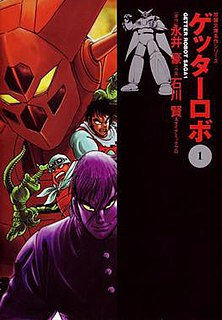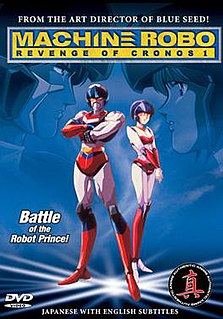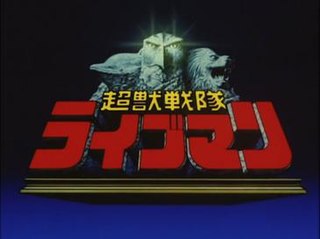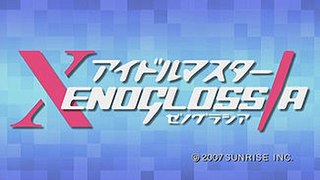
The Big O is a Japanese anime television series created by designer Keiichi Sato and director Kazuyoshi Katayama for Sunrise. The writing staff was assembled by the series' head writer, Chiaki J. Konaka, who is known for his work on Serial Experiments Lain and Hellsing.

Gekiganger III is an anime series within the anime series Martian Successor Nadesico that plays a critical part in the plot thereof. Gekiganger III was designed to mimic 1970s Super Robots, especially Getter Robo. Initially, only Gai Daigoji and Akito Tenkawa are depicted as enjoying the series. Later in the series, Hikaru Amano becomes the other resident anime fanatic, and towards the end of the series everyone on the ship learns to love the series.

Space Runaway Ideon is a 1980 anime television series produced by Sunrise, created and directed by Yoshiyuki Tomino, produced immediately following his most famous work, Mobile Suit Gundam. It first premiered on TV Tokyo from 1980 to 1981, followed by two feature films in 1982, and was later broadcast in Japan by the satellite TV network Animax from September 2006.

Divine Demon-Dragon Gaiking is a Japanese Super Robot mecha anime series produced by Toei Animation. For distribution purposes, Toei refers to this television series as Dino Mech Gaiking or simple Gaiking.
Great Mazinger is a manga comic book and anime television series by manga artist Go Nagai. The story is a sequel and direct continuation of Mazinger Z series after its initial success. The series was aired on Japanese television in 1974, immediately following the end of the first Mazinger series. It ran for 56 episodes.

Getter Robo is a Super Robot manga series created by Ken Ishikawa and Go Nagai, as well as an anime series produced by Toei Animation. The series was broadcast on Fuji TV from April 4, 1974 to May 8, 1975, with a total of 51 episodes. The manga was serialized in Shogakukan's Weekly Shōnen Sunday from April 7, 1974 to August 24, 1975.

Machine Robo: Revenge of Cronos, known in France as La Revanche des GoBots, is a Japanese anime television series produced by Ashi Productions. It ran on TV Tokyo from July 3, 1986, through May 28, 1987.
Getter Robo G, also known as Force Five: Starvengers in the United States, is a super robot anime series created by Go Nagai and Ken Ishikawa and produced by Toei Animation. This direct sequel to Getter Robo was broadcast on Fuji TV from May 15, 1975 to March 25, 1976, with a total of 39 episodes.

Choujuu Sentai Liveman is the twelfth entry of Toei Company's Super Sentai metaseries. The last Super Sentai title of the Shōwa period, it aired on TV Asahi from February 27, 1988 to February 18, 1989. Its international English title as listed by Toei is simply Liveman. The series was broadcast in France as Bioman 3, being marketed as the direct sequels to Choudenshi Bioman and Bioman 2.

GoShogun is a super robot anime series produced and aired in 1981 in Japan, with a movie special released in 1982 and a film sequel, GoShogun: The Time Étranger or Time Stranger, in 1985. Its title has been variously translated into English as "Demon God of the War-Torn Land GoShogun", "Warring Demon God GoShogun", and "Civil War Devil-God GoShogun," but in the US and parts of Europe it is primarily known as Macron 1, the title of its North American adaptation.

Brave Command Dagwon is a Japanese anime series begun in 1996, created by Takara and Sunrise under the direction of Tomomi Mochizuki and was the seventh Yūsha or "Brave" metaseries.

Lightspeed Electroid Albegas is an anime series that aired from 1983 to 1984 in Japan, Latin America, Spain and Italy. There were 45 episodes aired at 25 minutes each. Other loosely translated names are "Arbegas", "Arebegas", "Lightspeed ElectroGod Arbegas" and "Arbegas: El Rayo Custodio".

The Tatsumi family is a fictional family portrayed in the Japanese Super Sentai series Kyuukyuu Sentai GoGoFive. From a long line of "machi-bikeshi", the Tatsumi family are portrayed providing emergency and rescue services in Tokyo.

Go-wapper 5 Go-dam is an anime series aired in 1976. There were 36 episodes. It is also referred to as Godam and Gowapper 5 Gordam.

Invincible Robo Trider G7 is a Japanese mecha anime television series produced by Sunrise that aired from 1980 to 1981. It was also referred to as "Trider G7", "Unchallengeable Trider G7", "Tryder G7", "Bird Attack Tryder G7" and "Unrivaled Robot Trider G7".
Akio Nojima is a Japanese voice actor, actor and narrator from Nishitōkyō, Tokyo. His sons, Hirofumi Nojima and Kenji Nojima, are voice actors and his other son Satoshi is a nature writer. He was formerly affiliated with Tokyo Actor's Consumer's Cooperative Society and is attached to Sigma Seven as of 2016. He is most known for the roles of Saga in Saint Seiya and the Japanese voice of KITT in Knight Rider

Idolmaster: Xenoglossia is a 26-episode anime television series by Sunrise, based on the Namco Bandai Games series The Idolmaster. It aired between April 4 and September 24, 2007 on Kansai TV and various other UHF television stations. The series was also broadcast over the Internet on the Japanese website @nifty. The series has been licensed by Sentai Filmworks in North America. The word Xenoglossia in the title is a term taken from Greek for using a language that is completely unknown to the user.
Ginguiser is a Japanese mecha anime television series produced by Nippon Animation. It ran from April 9 to October 22, 1977.

Choriki Robo Galatt is a comedy-science fiction anime series by Sunrise. It is also known as Super Robot Galatt and Change Robo Galatt.



















